Author & Illustrator: Jan Brett (author and illustrator)
Publisher and Year: Penguin Random House LLC, 2015
Number of Pages: 30 Pages
Genre: Fantasy
Badger Girl comes across the biggest turnip she has ever seen in her vegetable garden. She asks for the help of family and friends to help her get the turnip out of the ground so the community can enjoy and eat the turnip.
The story serves as a window into how teamwork can accomplish many things. Even though it is unrealistic that animals perform these tasks, they represent how a community with a diverse group of individuals brings strength to the group. In the beginning, the turnip has the power because it will not come out of the ground. Badger Girl continues to fail because she is trying to pull the turnip out of the ground by herself. As the story continues on, other characters in the story attempt to help Badger Girl get the turnip out of the ground. Finally, the turnip finally comes out the ground when the power to help is distributed among all members of the community.
All the animals represent a different type of culture in society (not explicitly stated but they represent diverse groups of people in communities). The story shows that when all kinds of cultures come together to collaborate, things can be successfully accomplished. This theme can be applied to my understanding of culture as a whole because the more diverse cultures involved in a community, the better tasks can be completed. In addition, all animals had respect for one another’s differences. This is an important contribution to my understanding of culture because getting to know other cultures allows for barriers to be broken, which benefits the community as a whole. The pictures are very detailed, colorful, and large, which engages the reader into the artwork of the story. Also, all the animals have elaborate outfits, making them relatable to a human being. The borders include foreshadowing of the next images, which allow the reader to be creative and make predictions as to what will happen next in the story. The images are framed which make reader an observer of this fantasy world in the middle of the forest. The wide range of forest animals symbolizes different cultures among all kinds of people. The images and text once again mirror one other to allow the reader to follow along with the story visually and textually. The turnip symbolizes problems in a community that need teamwork of all members to be solved. Important ideologies from this story are teamwork, using differences to help one another, everyone offers a unique talent to help the group, and problems are not difficult to solve if everyone is involved to help.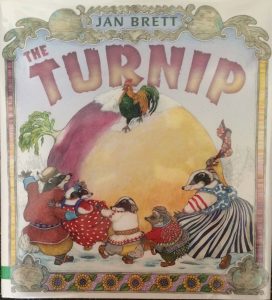
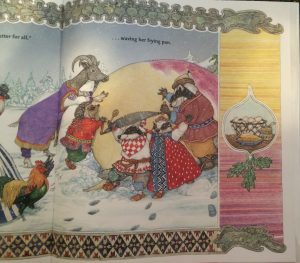

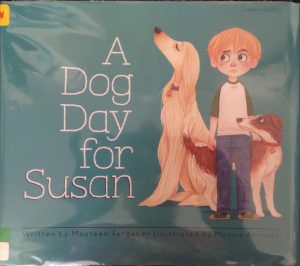

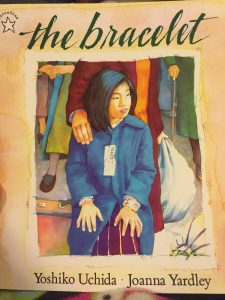
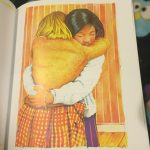
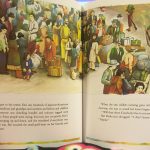
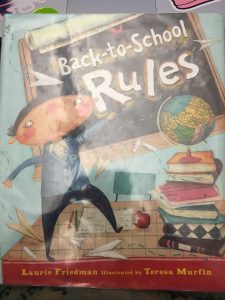 Title: Back-to-School Rules
Title: Back-to-School Rules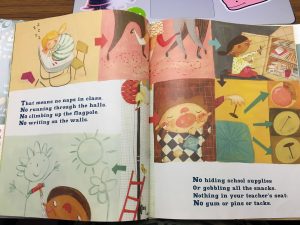 depicting the behaviors that Percy claims you should not do . Percy’s rules are often a different color in the text. The illustrator uses different techniques to display the information. For example, on one page, she uses arrows to display the order of which it appears in the text. On the next page, she uses a thought cloud to display the rules. The illustrator also uses a chalkboard to display the rules of Percy. Structurally, the text has a slight rhyming scheme. However, it is sometimes forced, making it difficult to hear the rhyming.
depicting the behaviors that Percy claims you should not do . Percy’s rules are often a different color in the text. The illustrator uses different techniques to display the information. For example, on one page, she uses arrows to display the order of which it appears in the text. On the next page, she uses a thought cloud to display the rules. The illustrator also uses a chalkboard to display the rules of Percy. Structurally, the text has a slight rhyming scheme. However, it is sometimes forced, making it difficult to hear the rhyming. Title: Not Afraid of Dogs
Title: Not Afraid of Dogs such as dogs, is normal and even common. The images, a Society of Children’s Book Writers and Illustrators’ Golden Kite Award for Illustrations winner, capture the emotions a child might have while facing their fears for the first time. For example, the cover picture shows Daniel climbing up a lamp post in the city when a group of dogs walk past him. Taking a first glance, the reader can easily tell the child is nervous and unfamiliar with dogs. The boy is usually placed on the opposite side of the dog, most of the time looking back to make sure he was safe from the dog. This is an accurate depiction of many other children who are afraid of or unsure of many animals. The text placement is not important in the story, however the author’s decision to emphasize Bandit’s howls in a different text size and alignment allows the reader to imagine the sound in their mind.
such as dogs, is normal and even common. The images, a Society of Children’s Book Writers and Illustrators’ Golden Kite Award for Illustrations winner, capture the emotions a child might have while facing their fears for the first time. For example, the cover picture shows Daniel climbing up a lamp post in the city when a group of dogs walk past him. Taking a first glance, the reader can easily tell the child is nervous and unfamiliar with dogs. The boy is usually placed on the opposite side of the dog, most of the time looking back to make sure he was safe from the dog. This is an accurate depiction of many other children who are afraid of or unsure of many animals. The text placement is not important in the story, however the author’s decision to emphasize Bandit’s howls in a different text size and alignment allows the reader to imagine the sound in their mind.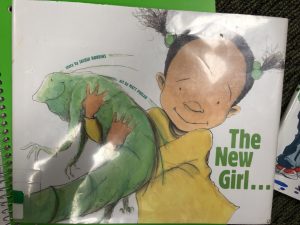
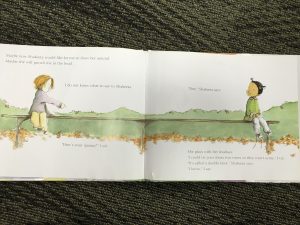

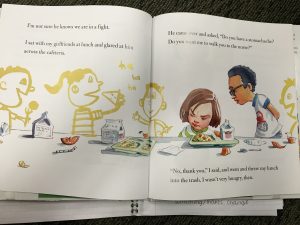 Perceptually, the images are very bright and enticing for the children. The use of faded watercolor pictures, such as in the picture below, allows the focus to remain on the narrator and James. The use of large text in certain areas allows the reader to recognize which points should be emphasized while reading the story aloud. Some of the illustrations resemble the ones that children would draw, making it very relatable for the readers. The layout of the text in relation to the pictures also allows the readers to follow the sequence very well, especially when the author is describing how each classmate heard the rumor about the narrator. Ideologically, this book shows the dangers of gossip and rumors and the effects they have on friendships. The misunderstanding during the “game of telephone” leads to the narrator’s feelings getting hurt by her best friend. Children who read this book are able to see the damage done by gossip and rumors. The ending of the book allows readers to see some things can be misunderstood and taken out of proportion. It also emphasizes the idea of friendship and its importance. The two sided story, the narrator and James’ actions, also show the different emotions when two friends are fighting. This book also gives an example of how children can solve problems with their friends. However, the way in which the narrator reacts is not recommended for children.
Perceptually, the images are very bright and enticing for the children. The use of faded watercolor pictures, such as in the picture below, allows the focus to remain on the narrator and James. The use of large text in certain areas allows the reader to recognize which points should be emphasized while reading the story aloud. Some of the illustrations resemble the ones that children would draw, making it very relatable for the readers. The layout of the text in relation to the pictures also allows the readers to follow the sequence very well, especially when the author is describing how each classmate heard the rumor about the narrator. Ideologically, this book shows the dangers of gossip and rumors and the effects they have on friendships. The misunderstanding during the “game of telephone” leads to the narrator’s feelings getting hurt by her best friend. Children who read this book are able to see the damage done by gossip and rumors. The ending of the book allows readers to see some things can be misunderstood and taken out of proportion. It also emphasizes the idea of friendship and its importance. The two sided story, the narrator and James’ actions, also show the different emotions when two friends are fighting. This book also gives an example of how children can solve problems with their friends. However, the way in which the narrator reacts is not recommended for children.![IMG_9614 [405971]](https://blogs.iwu.edu/lrbmt2016/files/2016/05/IMG_9614-405971-300x220.jpg)
![IMG_9615 [405972]](https://blogs.iwu.edu/lrbmt2016/files/2016/05/IMG_9615-405972-300x175.jpg)
![IMG_9616 [405973]](https://blogs.iwu.edu/lrbmt2016/files/2016/05/IMG_9616-405973-234x300.jpg)
![IMG_9617 [405974]](https://blogs.iwu.edu/lrbmt2016/files/2016/05/IMG_9617-405974-220x300.jpg)
![IMG_9618 [405975]](https://blogs.iwu.edu/lrbmt2016/files/2016/05/IMG_9618-405975-217x300.jpg)
![IMG_9619 [405976]](https://blogs.iwu.edu/lrbmt2016/files/2016/05/IMG_9619-405976-178x300.jpg) Analysis: “The Red Tree” is about a young girl who feels trapped in a world of—what seems to be—never-ending sadness. It is not until she realizes that she has to take the good with the bad that her “red tree” grows. This book works well as a mirror for a lot of young girls who feel that they are trapped in a bubble of sadness or sorrow. In the beginning, the young girl feels helpless and almost like she has no power over her life. By the end of the book, she is rejuvenated and hopeful. The images of darkness and confusion seem to be an accurate representation of what sadness would look like if it was tangible.
Analysis: “The Red Tree” is about a young girl who feels trapped in a world of—what seems to be—never-ending sadness. It is not until she realizes that she has to take the good with the bad that her “red tree” grows. This book works well as a mirror for a lot of young girls who feel that they are trapped in a bubble of sadness or sorrow. In the beginning, the young girl feels helpless and almost like she has no power over her life. By the end of the book, she is rejuvenated and hopeful. The images of darkness and confusion seem to be an accurate representation of what sadness would look like if it was tangible.